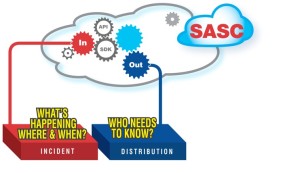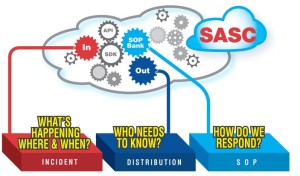Introduction
SASC is a web-based version of PSIM. It is a software platform that integrates and manages multiple devices (such as surveillance cameras & access controls) and data streams of security sensors by consolidating them all into one common user interface. When SASC is In Action, it does 4 things: Identifies an Incident. Distributes an Alert to everyone who needs to know. Enhances the Alert with detailed instructions on how to respond to the given event, per the given individual, to bring the Incident to resolution. Documents the incident to completion for a detailed Incident Report.
Step One: Incident
SASC connects to your existing hardware – including surveillance camera networks, access controls, fire & police alarms, intrusion alerts and GEO zones – via the cloud.
When these devices detect a change in the environment that you have identified as an Incident, SASC automatically identifies the event, or Incident and engages.
Step Two: Distribute
SASC then distributes Alerts to a predetermined list of people who Need to Know that the incident is occurring.
That list may include a Remote Monitoring Center, 911, field staff and management.
For every Incident, there is a unique Distribution list.
Step Three: Response
SASC includes instructions on how to Respond.
Those instructions, the Standard Operating Procedures or SOP, may vary depending on the individual.
For instance, if a utility substation is broken into, field staff could get different instructions than the instructions sent to management, or the ones sent to the Remote Monitoring Center.
Step Four: Report
SASC time stamps every incoming and outgoing data streams and Alerts throughout the event for a comprehensive Incident Report.






